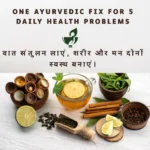Pitta Imbalance Remedies in Ayurveda: How to Cool Your Inner Fire Naturally
In Ayurveda, balance is everything. The three doshas—Vata, Pitta, and Kapha—govern your body’s functioning. Among them, Pitta dosha is associated with fire and water, controlling digestion, metabolism, and transformation in the body. Pitta Imbalance Remedies in Ayurveda offer natural, time-tested solutions for those experiencing excessive heat, acidity, irritability, or skin inflammation. Rooted in the wisdom of ancient texts like the Charaka Samhita, Ayurveda teaches that health is achieved when all three doshas—Vata, Pitta, and Kapha—are in balance. However, in today’s fast-paced lifestyle, Pitta dosha often gets aggravated due to stress, hot weather, spicy foods, and overexertion.
If you’ve been feeling physically overheated, emotionally irritable, or suffering from digestion issues and skin flare-ups, chances are your Pitta is out of balance. This article explores the most effective Ayurvedic remedies to reduce Pitta, restore internal harmony, and cool your body and mind naturally. You’ll also find a real-life case study and expert-approved recommendations for diet, herbs, lifestyle, and therapies.
But when Pitta becomes imbalanced, it can lead to excess heat, inflammation, anger, and even skin disorders. If you’re feeling overheated—physically or emotionally—Ayurveda offers powerful, time-tested remedies to bring your Pitta back into harmony.
In this blog, you’ll learn:
-
What causes Pitta imbalance
-
Symptoms to watch out for
-
Real-life case study
-
Natural Ayurvedic remedies for Pitta imbalance
-
Diet, lifestyle, herbs, and therapies
-
FAQs and expert tips
What Is Pitta Dosha?
Pitta is the dosha of fire and water. It governs:
-
Digestion and metabolism
-
Body temperature
-
Hormonal balance
-
Intelligence and decision-making
-
Skin coloration and luster
When balanced, Pitta individuals are energetic, sharp-minded, and have good digestion. When imbalanced, they may experience inflammation, anger, and skin issues.
What Causes Pitta Imbalance?
Excess Pitta is triggered by:
-
Overexposure to heat (weather or spicy food)
-
Irregular eating habits
-
Excess alcohol, caffeine, or fried food
-
Emotional stress or suppression
-
Overworking or perfectionism
Common Symptoms of Pitta Imbalance
If your Pitta is high, you may notice:
Physical Symptoms
-
Acid reflux or heartburn
-
Loose stools or diarrhea
-
Excessive sweating or body odor
-
Inflammation or rashes
-
Premature graying or hair loss
Emotional/Mental Symptoms
-
Irritability or anger
-
Impatience or frustration
-
Over-critical mindset
-
Perfectionism
-
Disturbed sleep
Case Study: Reversing Pitta Imbalance Naturally
Name: Aastha Sharma
Age: 34
Location: Pune, India
Occupation: Corporate Lawyer
Background:
Aastha led a high-pressure corporate life with long hours, skipped meals, and constant deadlines. She often relied on coffee, spicy snacks, and late-night work marathons.
Symptoms:
-
Daily acidity and heartburn
-
Angry outbursts and irritability
-
Redness and breakouts on face
-
Interrupted sleep
Ayurvedic Diagnosis:
Classic Pitta aggravation due to lifestyle and dietary habits.
Treatment Protocol (2 Months):
-
Diet: Switched to Pitta-pacifying diet—more cooling foods like cucumber, coconut, and bitter gourd.
-
Herbs: Prescribed Avipattikar Churna and Guduchi capsules.
-
Lifestyle: Daily Abhyanga (self-massage with cooling oils) + 20 min evening walks.
-
Yoga: Started cooling asanas like Shitali Pranayama, Moon Salutation, and forward bends.
Results after 8 weeks:
-
Acidity completely gone
-
Clearer skin
-
Milder temperament
-
Improved sleep quality
This case shows how small but consistent Ayurvedic practices can heal the root cause, not just the symptoms.
Top Ayurvedic Remedies for Pitta Imbalance
Ayurveda offers a holistic approach that includes diet, lifestyle, herbs, and therapies. Let’s look at them one by one.
1. Pitta-Pacifying Diet
Focus on foods that are:
-
Cooling
-
Sweet, bitter, or astringent in taste
-
Hydrating and light
What to Eat
-
Fruits: Melon, grapes, pomegranate, apple
-
Vegetables: Cucumber, zucchini, bitter gourd, spinach
-
Grains: Rice, oats, barley
-
Dairy: Cow’s milk (lukewarm), ghee, buttermilk
-
Spices: Fennel, coriander, cardamom, turmeric
What to Avoid
-
Spicy, sour, and salty foods
-
Tomatoes, onions, garlic
-
Fried and fermented foods
-
Caffeine and alcohol
-
Red meat and seafood
2. Lifestyle Changes to Balance Pitta
Pitta needs cooling, calmness, and flow.
Recommended Habits
-
Wake up early before 6 AM (Pitta time starts from 10 AM)
-
Daily self-massage with cooling oils (like Brahmi or coconut oil)
-
Walks in nature or moonlight
-
Taking breaks from screens and stress
-
Spend time with calm people and soothing music
Avoid
-
Overworking and competitiveness
-
Intense workouts during peak heat (10 AM – 2 PM)
-
Arguments and loud environments
3. Best Ayurvedic Herbs for Pitta Balance
1. Amla (Indian Gooseberry)
-
Rich in Vitamin C and antioxidants
-
Cools and detoxifies liver and blood
2. Guduchi (Giloy)
-
Anti-inflammatory and immunity-boosting
-
Helps with skin problems, acidity, and liver issues
3. Shatavari
-
Nourishing and cooling
-
Excellent for hormonal Pitta imbalances
4. Neem
-
Detoxifies blood
-
Helps with skin eruptions and heat rashes
5. Avipattikar Churna
-
Herbal powder for acidity, gastritis, and hyperacidity
Consult an Ayurvedic practitioner for customized dosage.
4. Panchakarma Therapies for Deep Detox
Panchakarma is a five-step detox process that eliminates accumulated doshas.
Recommended for Pitta:
-
Virechana (Therapeutic Purgation): Best to expel excess Pitta from liver and intestines
-
Takradhara: Cooling medicated buttermilk poured on the forehead to calm the mind
-
Pitta balancing Abhyanga: Oil massages with Brahmi or Chandanadi Tailam
These therapies should always be done under guidance at a certified Ayurvedic center.
5. Pitta-Balancing Yoga and Pranayama
Pitta minds are intense. Cooling yoga postures and breathwork help restore emotional balance.
Recommended Asanas
-
Forward bends (Paschimottanasana)
-
Moon Salutation (Chandra Namaskar)
-
Shoulder stand (Sarvangasana)
-
Child’s Pose (Balasana)
Pranayama
-
Sheetali (cooling breath)
-
Sheetkari
-
Nadi Shodhana (alternate nostril breathing)
Simple DIY Pitta Remedy Recipes
1. Pitta Tea
Ingredients:
-
1 tsp fennel seeds
-
1 tsp coriander seeds
-
1 tsp mint leaves
Instructions: Boil in 2 cups water for 10 minutes. Cool slightly and drink.
2. Amla Juice with Aloe Vera
Take 20 ml Amla juice + 20 ml Aloe vera juice in 100 ml water on empty stomach daily.
3. Cooling Cucumber Raita
Grate cucumber in curd, add mint, coriander, rock salt – a perfect side dish for lunch.
Expert Tips for Long-Term Pitta Management
-
Avoid working during noon heat
-
Keep aloe vera gel handy for skin flare-ups
-
Use rose water spray during summers
-
Spend time near water bodies
-
Practice gratitude journaling to reduce inner anger
Final Thoughts: Cool the Fire Before It Burns You Out
Pitta imbalance is common in today’s high-pressure, fast-paced world. But you don’t need to suffer from constant acidity, anger, or inflammation.
With Ayurveda, the solution is natural, holistic, and personalized. By making mindful changes in your diet, lifestyle, and mindset, you can restore balance and live with clarity and calm.
Frequently Asked Questions (FAQs)
Yes. Excess Pitta can lead to hormonal disruptions and inflammation that affect reproductive health. Herbs like Shatavari and therapies like Virechana can help.
Not always. Skipping meals can aggravate Pitta. Instead, eat small, regular meals.
Yes. Excess heat in the body can cause premature greying, dandruff, and hair thinning.
Depending on severity, it can take 4 to 12 weeks with consistent dietary, lifestyle, and herbal interventions.
Read more : Dosha Imbalance Symptoms and Ayurvedic Treatment


